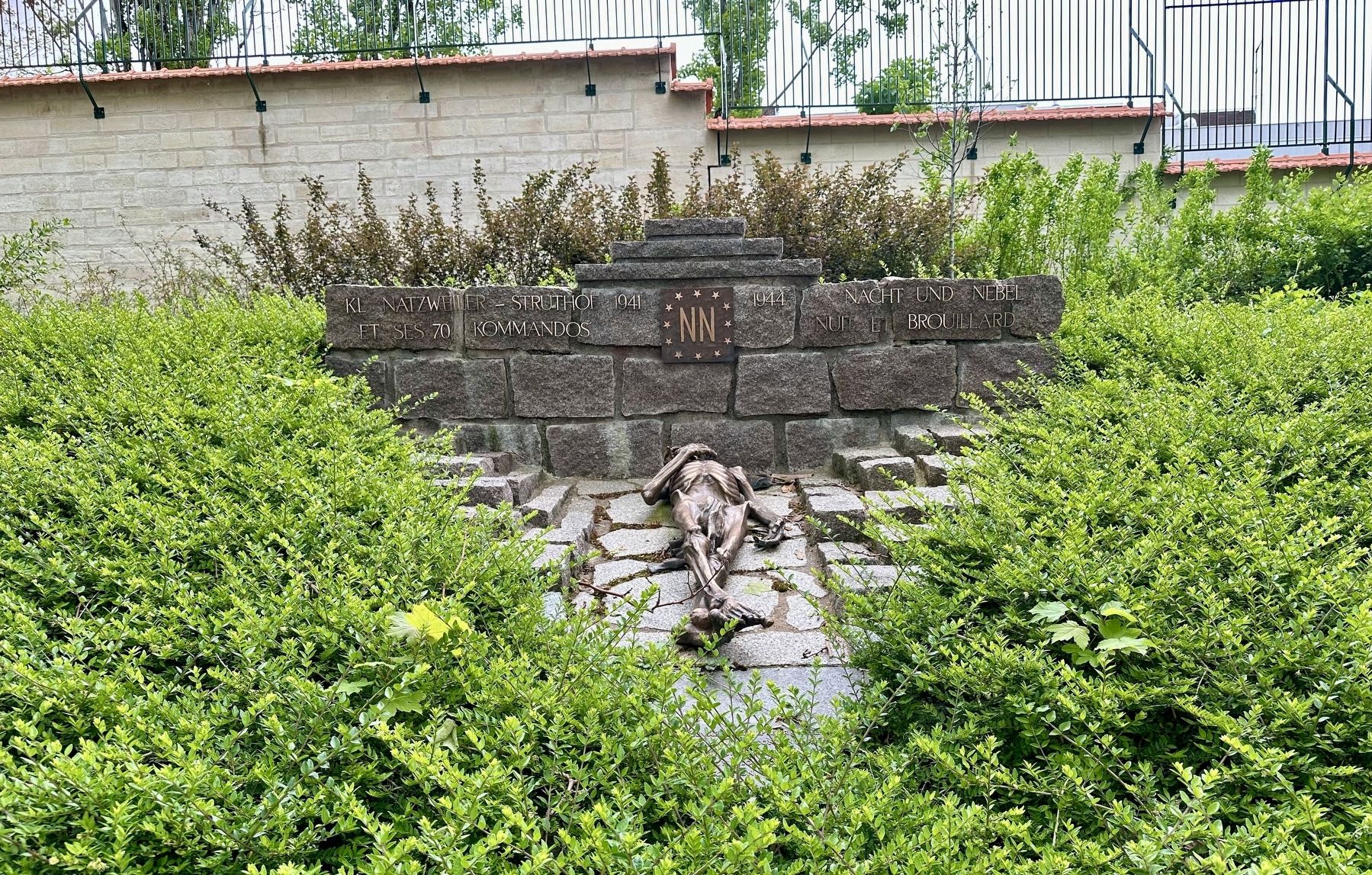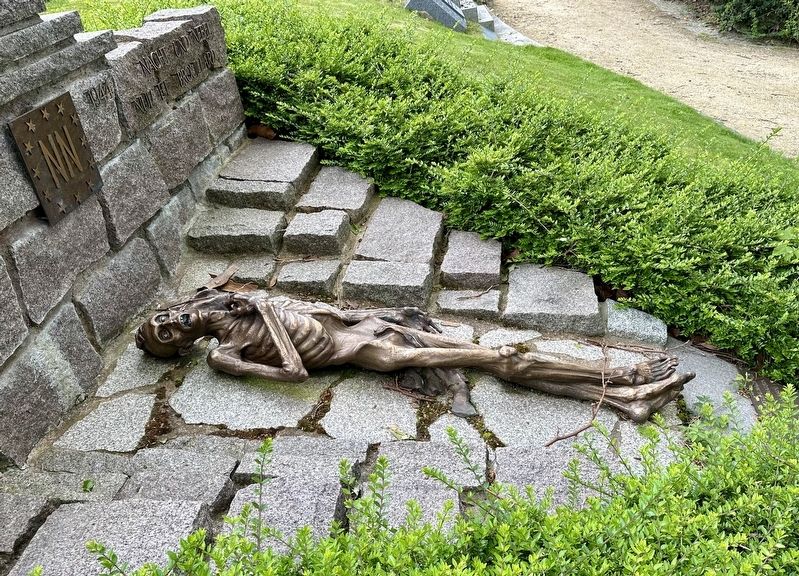Père-Lachaise in Paris in Département de Paris, Île-de-France, France — Western Europe
Natzweiler-Struthof Concentration Camp Memorial
Inscription.
KL Katzweiler-Struthof et ses 70 Kommandos
1941 1944
Nacht und Nebel
Nuit et Bruillard
1941 1944
“Night and Fog”
Erected 2004.
Topics and series. This memorial is listed in this topic list: War, World II. In addition, it is included in the The Holocaust series list.
Location. 48° 51.617′ N, 2° 23.996′ E. Marker is in Paris, Île-de-France, in Département de Paris. It is in Père-Lachaise. Memorial is on Avenue Circulaire, on the right when traveling north. The memorial is in Pere Lachaise Cemetery, along the cemetery wall along Avenue Circulaire, amongst the other concentration camp memorials, in Section 77. Touch for map. Marker is in this post office area: Paris, Île-de-France 75020, France. Touch for directions.
Other nearby markers. At least 8 other markers are within walking distance of this marker. Auschwitz III Concentration Camp Memorial (a few steps from this marker); Buchenwald-Dora Concentration Camp Memorial (a few steps from this marker); Sachsenhausen-Oranienburg Concentration Camp Memorial (a few steps from this marker); Jewish Children Holocaust Memorial (a few steps from this marker); Auschwitz-Birkenau Extermination Camp Memorial (within shouting distance of this marker); Communist Women’s Memorial (within shouting distance of this marker); Ravensbruck Concentration Camp Memorial (within shouting distance of this marker); Neuengamme Concentration Camp Memorial (about 90 meters away, measured in a direct line). Touch for a list and map of all markers in Paris.
Also see . . .
1. Natzweiler-Struthof concentration camp (Wikipedia).
Overview: Natzweiler-Struthof was a Nazi concentration camp located in the Vosges Mountains close to the villages of Natzweiler and Struthof in the Gau Baden-Alsace of Germany, on territory annexed from France on a de facto basis in 1940. It operated from 21 May 1941 to September 1944, and was the only concentration camp established by the Germans in the territory of pre-war France. The camp was located in a heavily-forested and isolated area at an elevation of 800 metres (2,600 ft).(Submitted on April 20, 2024.)
About 52,000 prisoners were estimated to be held there during its time of operation. The prisoners were mainly from the resistance movements in German-occupied territories. It was a labor camp, a transit camp and, as the war went on, a place of execution. Some died of exhaustion and starvation – there were an estimated 22,000 deaths at the camp and its network of subcamps. Many prisoners were moved to othercamps; in particular, in 1944 the former head of Auschwitz concentration camp was brought in to evacuate the prisoners of Natzweiler-Struthof to Dachau as the Allied armies approached. Only a small staff of Nazi SS personnel remained when the camp was liberated by the French First Army under the command of the U.S. Sixth Army Group on 23 November 1944.
The anatomist August Hirt made a Jewish skull collection, whose purpose was to portray Jews as racially inferior, at the camp. A documentary movie was made about the 86 named men and women who were killed there for that project. Some of the people responsible for atrocities in this camp were brought to trial after the war ended. The camp is preserved as a museum in memory of those held or killed there…
2. Natzweiler-Struthof (United States Memorial Holocaust Museum).
Excerpt: Prisoners in the Camp - Beginning in the summer of 1943, the Germans detained many "Night and Fog" prisoners in Natzweiler-Struthof. The "Night and Fog" (Nacht und Nebel) operation represented a German attempt to subdue growing anti-German resistance in western Europe. Suspected resistance fighters were arrested and their families were not notified; the prisoners simply disappeared into the "Night and Fog." Many prisoners in the Natzweiler-Struthof camp were members of the French resistance.(Submitted on April 20, 2024.)
3. Night and Fog Decree (United States Memorial Holocaust Museum)
.
Excerpt: "Nacht und Nebel" ("Night and Fog") was the codename given to a decree of December 7, 1941, issued by Adolf Hitler and signed by Field Marshal Wilhelm Keitel, Chief of the German Armed Forces High Command. It allowed German authorities to abduct individuals alleged to be "endangering German security" so that they effectively vanished without a trace.(Submitted on April 20, 2024.)
The "Night and Fog" decree was directed against persons in occupied territories engaging in activities intended to undermine the security of German troops. They were, upon capture, to be brought to Germany "by night and fog" for trial by special courts. This circumvented military procedure and various conventions governing the treatment of prisoners. The code name stemmed from Germany's most acclaimed poet and playwright, Johann Wolfgang von Goethe (1749–1832), who used the phrase to describe clandestine actions often concealed by fog and the darkness of night.
Additional keywords. Holocaust
Credits. This page was last revised on April 20, 2024. It was originally submitted on April 20, 2024, by Andrew Ruppenstein of Lamorinda, California. This page has been viewed 51 times since then. Photos: 1, 2, 3. submitted on April 20, 2024, by Andrew Ruppenstein of Lamorinda, California.


